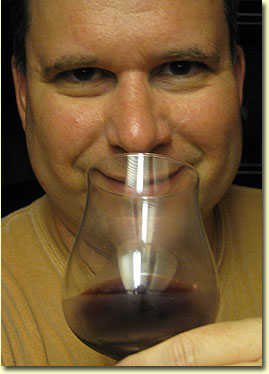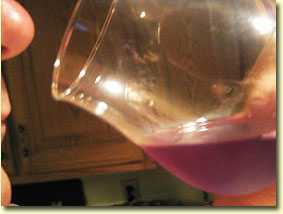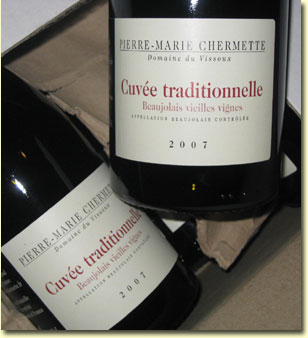 |
|
|
I've been on hiatus for a while. As it is apt to do, life has thrown a few curves, and part of my reaction has been to reevaluate how I expend my energies. I have continued the exploration of wine, albeit with less focus. It became hard for me to see value and merit in casting my words into cyberspace, but once again it seems I might forget about seeking justification and simply return to something I have enjoyed.
Chermette has been committed to naturally ripe wines (no chaptalization), low yields, the use of indigenous yeast, and minimal added sulfites. Certainly his attention to detail, care and use (or non-use) of varying techniques moves far past the above mentioned, but those elements set the stage for what are typically very fresh, vibrant wines. The other great feature of this wine has been price -- most having been purchased in the low to mid teens....the latest vintage (2007) has moved to about $20 in some locations. The wine is imported by Weygandt - Metzler. I offer a composite of my experiences with these wines, as I have sampled them often in recent months. Substantial discrepancies in bottles have been noted, but most have shown quite consistently since the start of the new year. |
|
|
Domaine du Vissoux Beaujolais
Cuvée Traditionnelle Vieilles Vignes
2001 In drinking this wine over a number of years, I have always found it well proportioned with red, rich fruit and mineral laced soil...soft textures, draped over a fairly rigid frame. Clearly it was a fine example of Beaujolais. The last two bottles have struck me differently, seeming more like a good Chinon or Bourgueil from the Loire. The fruit seemed darker and an herbaceous core became more evident. The textures are smooth, though drawn tight and lean with acids. This was a very interesting and unexpected evolution. While still compelling , its best days as Beaujolais may be gone. Find this wine 2002
The years have made it more delicate. Where once the floral tones were more akin to a long lingering perfume, they now have a quality of a passing summer breeze, gathering up some lavender along the way. The fragrances and flavors put me in mind of picking my own strawberries, and biting into the juicy, sun warmed bounty as I crawl along the dusty aisle. I recall this seeming just a bit more ripe, but I'm even happier with its greater transparency. As it ages, it reminds me more and more of a perfect summer day. The day stretches on into what used to be night...pleasantly long and filled with delight. Find this wine 2003 As much as I sing the praises of the Cuvee Traditionnelle, I never liked this vintage. On hope and faith I purchased three bottles. At release it was filled with plum and red jam. It was luscious, soft and round in the mouth. Friends who hated the very idea of Beaujolais found this one pretty appealing. What's wrong with all that? Not much, I guess, as it was pleasant, easy, and drinkable (not brandishing too much alcohol, even with the ripeness). Still, it was non-descript. It lacked depth and verve. If the 2002 were a cool summer breeze, this was a hot, muggy August day where your red popsicle melts down your arm. My last bottle sat in the cellar for a long time, but I was feeling optimistic a few weeks back...in hindsight, "sticky red popsicle arm" was not so bad. A still substantial ball of black fruit had a sizable hole in its center. It was flabby and unmotivated. The alcohol was noticeable (even after a chill), but not at all horrible. No worries -- it was an inexpensive experiment. Find this wine 2004
The 2004 CT continues to glisten with verve and acidic snap,
with no real hindrance to the pure red fruits. Tobacco, citrus
and earth elements have begun to emerge in the lingering finish,
but the mineral strain still runs from end to end. The wine
remains fun and easy to drink, but sacrificing no sense of
interest. I wish I had another case, as its synthesis of fruit
and snappy structure make me believe it still has a fine
future. 2005 The 2005 model has always been very different. Where the 2002's and 2004's always had a very sunny disposition -- light and scintillating -- this has always struck me as a more cool and intense form. The wine brings more heft and darker fruit. The tannins push past the acid. Still, it drank well early. I found myself pondering its depths, but still sipping and sniffing with gusto. I knew this was a wine to hold and let develop, but its visceral appeal and intrigue were compelling draws. After welling up the fortitude to let these bottles sit, I took a nearly year long hiatus from them. Two recent bottles have shown me I need to wait longer.
The fruit still sports a darker tinge, and it remains broad and
dense in its conveyance. The tannic strength remains, but the
acids now seem to lend it a bit of that familiar brightness. The
fragrances are a pistou of turned earth, herbs and wild flowers.
What the wine presently lacks is precision and clarity. It
appeared to lack harmony, and seemed compartmentalized. It was
certainly drinkable, but as hard as I wished it, I could 2006 Upon release this bottle seemed lean and taut, but bright and glistening with acidity. I have a fondness for higher acid wines, and had no issues with this change of pace from juicier, more rounded previous vintages. A year or more in the cellar has brought out a very different expression -- a wine that is amazingly gulpable. Recent bottles have shown consistent freshness, with various earth, herbal and cola fragrances. It cascades around the mouth as a rolling orb of juicy, natural (neither syrupy, nor some caricature of the fruit) blackberry and anise. The acids spike, and make for a relatively compact, chalk and mineral laced finish. Fun and appealing, gulp after gulp, it is a wine that does not demand your attention, so much as it makes one peer down at the glass and smile in conversational lulls. At risk of stating the obvious, I am inclined to drink this wine in the nearer term. Find this wine 2007
LM
|
|

 I am back with a survey of recent vintages of
I am back with a survey of recent vintages of

 This was the first Cuvee
Traditionnelle on which I
went long -- purchasing at least a case. I was immediately
smitten by the remarkable harmony between the components --
never seeming to possess too little or too much of any one
element. Years removed from release, it continues as such.
Perception of balance is a very desirable commodity in the wines
I drink, but beyond any hypothetical equilibrium lies a desire
to find intrigue, interest and enjoyment -- these qualities
remain in the 2002 version of Cuvee Traditionnelle.
This was the first Cuvee
Traditionnelle on which I
went long -- purchasing at least a case. I was immediately
smitten by the remarkable harmony between the components --
never seeming to possess too little or too much of any one
element. Years removed from release, it continues as such.
Perception of balance is a very desirable commodity in the wines
I drink, but beyond any hypothetical equilibrium lies a desire
to find intrigue, interest and enjoyment -- these qualities
remain in the 2002 version of Cuvee Traditionnelle. My memory of this wine will
always be that of gorgeous, bright Beaujolais. Two cases have
nearly vanished from my cellar, and I cannot remember a bottle
that was not a pleasure. This is not to say that it has not
changed. I recall a number of the Bojo-intelligensia who
recoiled a bit at its initial green streak. Though the depth of
the pure strawberry fruit and span of mineral intensity had me
viewing it as an appealing herbal nuance, rather than any
deficit. Obviously we all have different tolerances, though as
time went by, this green/herbal element became even less
pronounced, with the last bottles consumed making it hardly
noteworthy at all. I tend to believe many of the better 2004 Red
Burgundies will follow a similar track, and shed the "green"
label that has been ascribed to them in still early stages of
development...but then, this is perhaps a separate discussion.
My memory of this wine will
always be that of gorgeous, bright Beaujolais. Two cases have
nearly vanished from my cellar, and I cannot remember a bottle
that was not a pleasure. This is not to say that it has not
changed. I recall a number of the Bojo-intelligensia who
recoiled a bit at its initial green streak. Though the depth of
the pure strawberry fruit and span of mineral intensity had me
viewing it as an appealing herbal nuance, rather than any
deficit. Obviously we all have different tolerances, though as
time went by, this green/herbal element became even less
pronounced, with the last bottles consumed making it hardly
noteworthy at all. I tend to believe many of the better 2004 Red
Burgundies will follow a similar track, and shed the "green"
label that has been ascribed to them in still early stages of
development...but then, this is perhaps a separate discussion.
 The Cuvee
Traditionnelle is typically around 12% abv, which
makes it all the more remarkable at the level of juicy ripeness
the wines are able to bring forth. The 2007 tilts toward black
fruits, putting me in mind of black raspberries. Salty minerals
and dark dirt mingle with the fruit. The intense flavors are
mouth filling and silky, but as expected, they are given real
verve by the acidic wash. Pine forest, violets and porcini add
to an enticing bouquet. This is exciting wine. I have
only enjoyed one bottle from this vintage, but I immediately
ordered more.
The Cuvee
Traditionnelle is typically around 12% abv, which
makes it all the more remarkable at the level of juicy ripeness
the wines are able to bring forth. The 2007 tilts toward black
fruits, putting me in mind of black raspberries. Salty minerals
and dark dirt mingle with the fruit. The intense flavors are
mouth filling and silky, but as expected, they are given real
verve by the acidic wash. Pine forest, violets and porcini add
to an enticing bouquet. This is exciting wine. I have
only enjoyed one bottle from this vintage, but I immediately
ordered more.